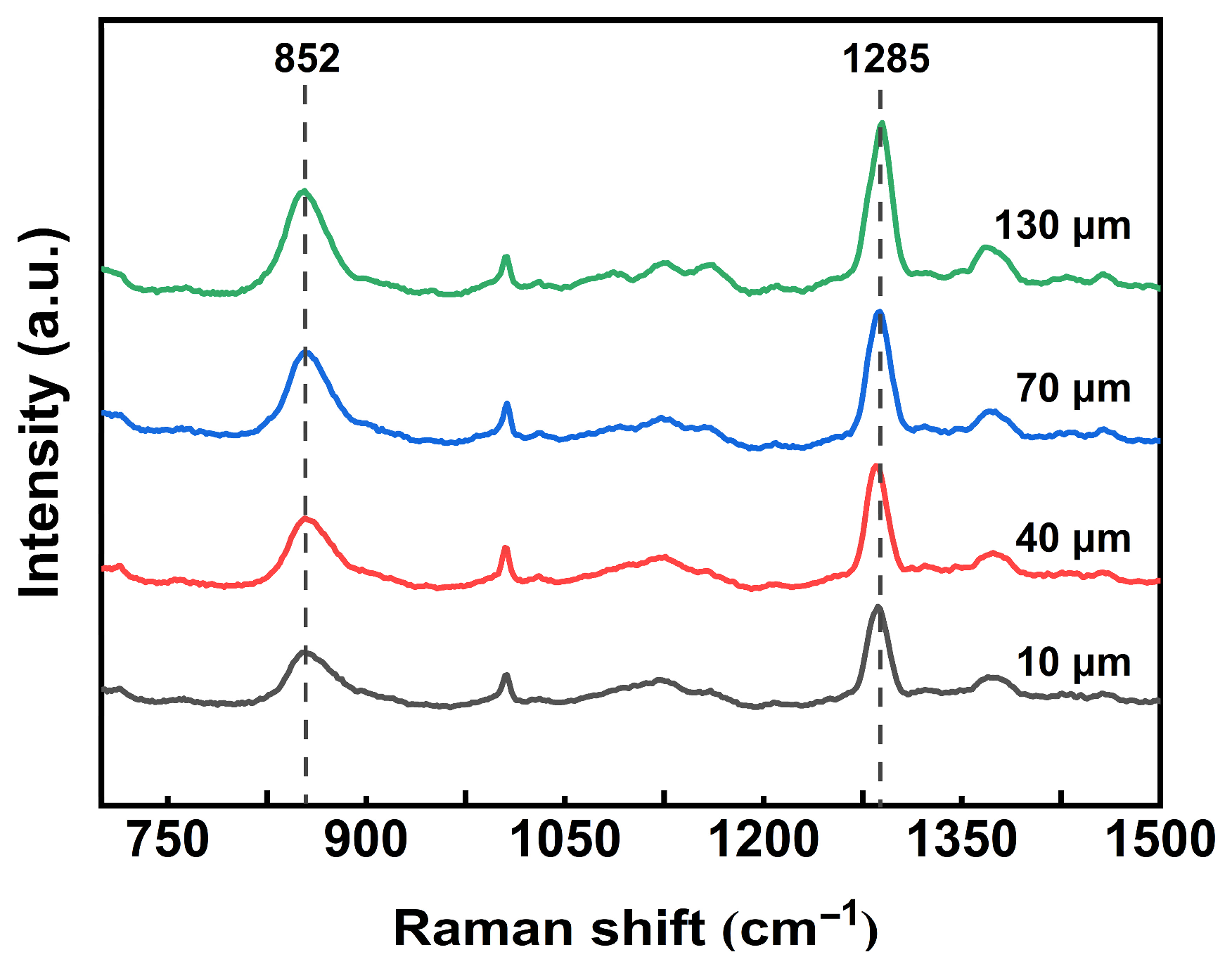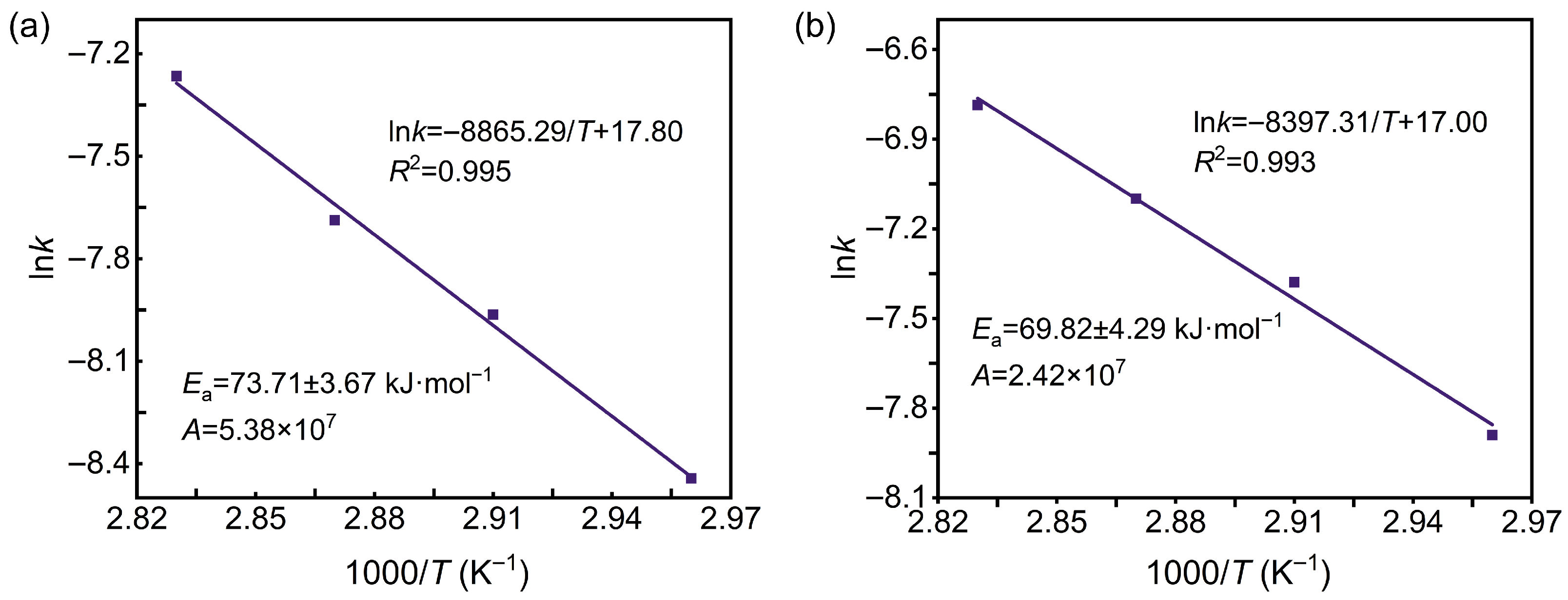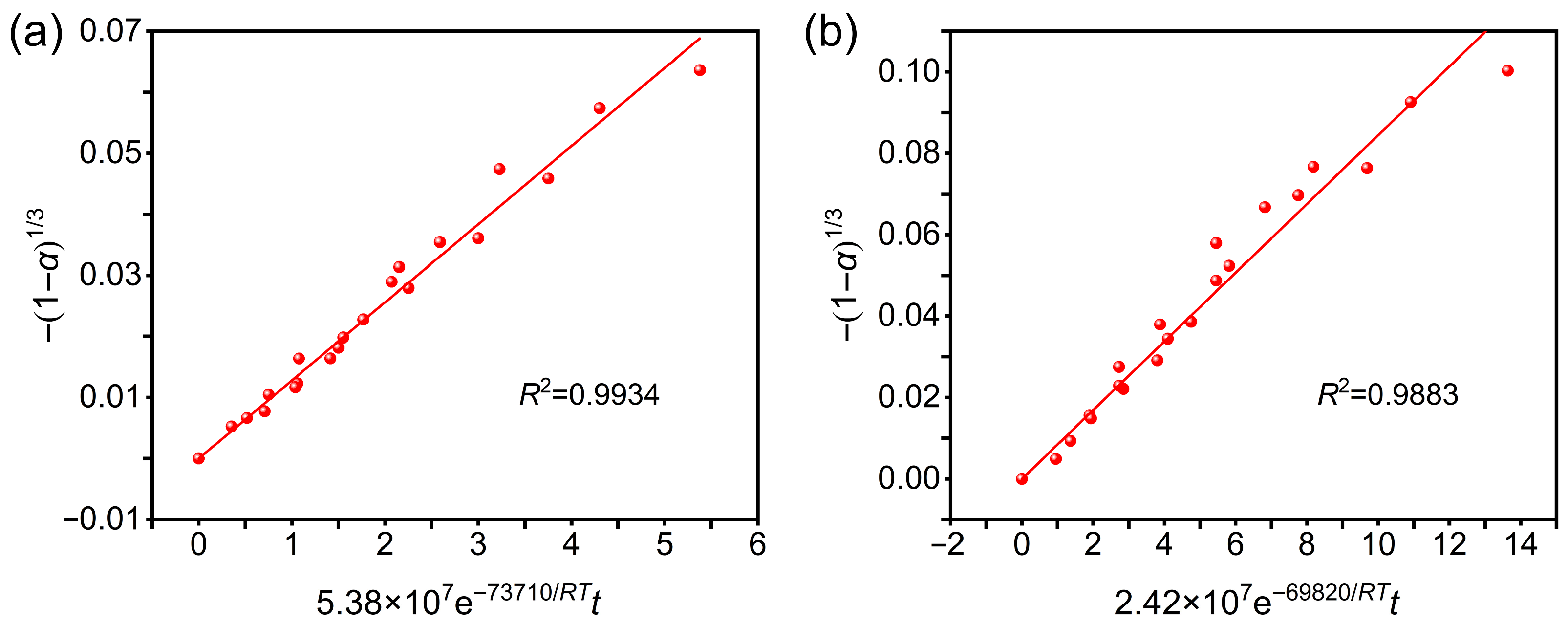Reaction Kinetics of Nitrocellulose Denitration: Model Comparison and Mechanistic Insights
Abstract
1. Introduction
2. Experiments
2.1. Materials and Chemicals
2.2. Preparation of Surface-Denitrated Spherical Gun Propellants
2.3. Denitration Mechanism of Spherical Gun Propellant
2.4. Characterization
3. Results and Discussion
3.1. Structural Characterization
3.2. Analysis of the Denitration Process of Nitrocellulose in Spherical Gun Propellant
3.3. Kinetic Analysis
3.3.1. Selection of Kinetic Models
3.3.2. Fitting of Kinetic Models
3.3.3. Validation of the Kinetic Model
4. Conclusions
Supplementary Materials
Author Contributions
Funding
Data Availability Statement
Acknowledgments
Conflicts of Interest
References
- Manning, T.; Wyckoff, J.; Klingaman, K.; Panchal, V.; Rozumov, E.; Bolognini, J.; Young, M.W.; Patel, S. Enhanced propellant performance via environmentally friendly curable surface coating. Def. Technol. 2017, 13, 131–142. [Google Scholar] [CrossRef]
- Liang, H.; Ding, Y.J.; Li, S.Y.; Xiao, Z.L. Combustion performance of spherical propellants deterred by energetic composite deterring agents. ACS Omega 2021, 6, 13024–13032. [Google Scholar] [CrossRef] [PubMed]
- Chen, L.; Zhang, J.W.; Meng, D.R.; Cao, X.; Wang, B.B.; Nan, F.Q.; Chen, F.Y.; Du, P.; Liao, X.; He, W.D. Construction of nitrate glycerol ether cellulose/RDX energetic composite in gun propellants and its comprehensive performance. Cellulose 2024, 31, 5725–5745. [Google Scholar] [CrossRef]
- Liu, B.; Ma, F.S.; Bian, X.Y.; Tian, D.Q.; Wang, Q.L.; Lv, H. Research on the Performance of Deterred-coating DIANP Gun Propellant. J. Phys. Conf. Ser. 2023, 2478, 032006. [Google Scholar] [CrossRef]
- Gou, Y.L.; Wei, L.; Yao, Y.J.; Liu, B.; Wang, J.P. Combustion performance of surface-deterred gun propellants with varied deterrent contents. J. Phys. Conf. Ser. 2023, 2478, 032004. [Google Scholar] [CrossRef]
- Moskovchenko, A.; Vantner, M.; Honner, M. Detection of gunshot residue by flash-pulse and long-pulse infrared thermography. Infrared Phys. Technol. 2024, 140, 12. [Google Scholar] [CrossRef]
- Mcneilly, R.J.; Schwanekamp, J.A.; Hyder, L.S.; Hatch, J.P.; Edwards, B.T.; Kirsh, J.A.; Jackson, J.M.; Jaworek, T.; Methner, M.M.; Duran, C.M. Exposure to lead-free frangible firing emissions containing copper and ultrafine particulates leads to increased oxidative stress in firing range instructors. Part. Fibre Toxicol. 2022, 19, 36. [Google Scholar] [CrossRef]
- Ding, Y.J.; Ying, S.J.; Xiao, Z.L.; Wu, W.L.; Li, C.Z.; He, Y. Microcellular Oblate Propellant with Skin-core Structure Deterred by Poly(neopentanediol adipate). Cent. Eur. J. Energ. Mat. 2020, 17, 49–65. [Google Scholar] [CrossRef]
- Li, X.Y.; Wu, R.; Li, Z.C.; Chen, G.; Zhou, H.B.; Zhang, Y.C.; Xiao, Z.G. Study on the erosion reducing mechanisms of microencapsulated hydroxyl silicone oil with a hybrid shell. Mater. Lett. 2025, 401, 139196. [Google Scholar] [CrossRef]
- Wang, D.L.; Liang, H.; Li, H.W.; Chu, Y.K.; Ding, S.X.; Xu, B. Can the gradient distribution and antimigration of deterrents in nitrocellulose-based propellant be balanced?: A strategy for small molecule diffusion followed by UV-induced curing. Cellulose 2025, 32, 2955–2971. [Google Scholar] [CrossRef]
- Saito, Y.; Okada, K.; Endo, T.; Sakakibara, K. Highly surface-selective nitration of cellulose nanofibers under mildly acidic reaction conditions. Cellulose 2023, 30, 10083–10095. [Google Scholar] [CrossRef]
- Aljafree, N.F.A.; Norrrahim, M.N.F.; Samsuri, A.; Yunus, W.M.Z.W. Advancements in nitrated nanocellulose: From structural insights to energetic applications. Cellulose 2025, 32, 8047–8099. [Google Scholar] [CrossRef]
- Boukeciat, H.; Tarchoun, A.F.; Trache, D.; Abdelaziz, A.; Bouhantala, A.; Boustila, C.; Klapötke, T.M.; Thakur, S. Development and characterization of innovative energetic composites based on nitrotriazolone and nanostructured cellulose nitrates. Cellulose 2024, 31, 5479–5498. [Google Scholar] [CrossRef]
- Li, S.Y.; Tao, Z.A.; Ding, Y.J.; Liang, H.; Zhao, X.Z.; Xiao, Z.L.; Li, C.Z.; Ou, J.Y. Gradient denitration strategy eliminates phthalates associated potential hazards during gun propellant production and application. Propellants Explos. Pyrotech. 2020, 45, 1156–1167. [Google Scholar] [CrossRef]
- Li, S.Y.; Li, Y.; Ding, Y.J.; Liang, H.; Xiao, Z.L. One-step green method to prepare progressive burning gun propellant through gradient denitration strategy. Def. Technol. 2021, 22, 135–143. [Google Scholar] [CrossRef]
- Sweygers, N.; Depuydt, D.E.C.; Van Vuure, A.W.; Degrève, J.; Potters, G.; Dewil, R.; Appel, L. Simultaneous production of 5-hydroxymethylfurfural and furfural from bamboo (Phyllostachys nigra “Boryana”) in a biphasic reaction system. Chem. Eng. J. 2020, 386, 123957. [Google Scholar] [CrossRef]
- Wu, W.F.; Wang, C.Y.; Wang, X.R.; Li, H.Q. Removal of V and Fe from spent denitrification catalyst by using oxalic acid: Study of dissolution kinetics and toxicity. Green. Energy Environ. 2021, 6, 660–669. [Google Scholar] [CrossRef]
- Li, S.J.; Zhu, J.X. Leaching kinetics of fluorine during the aluminum removal from spent Li-ion battery cathode materials. J. Environ. Sci. 2024, 138, 312–325. [Google Scholar] [CrossRef]
- Wen, G.D.; Yuan, S.; Liu, J.; Dong, Z.Z.; Han, R.; Ding, H.Y.; Lei, S.L.; Li, Z.H.; Wang, W.Z.; Cao, Y.D. Process optimization for recycling spent lithium iron phosphate batteries based on leaching kinetics and mechanism study. Sep. Purif. Technol. 2025, 370, 133263. [Google Scholar] [CrossRef]
- Chen, S.L.; Wang, X.; Li, H.; Guan, X.T.; Fan, Y.Q.; Yan, Y.C.; Guo, Z.P.; He, H.B.; Long, H.M. Optimizing lithium recovery from artificial β-spodumene slags: A breakthrough in pyrometallurgical processing of spent lithium-ion batteries. J. Environ. Chem. Eng. 2025, 13, 117291. [Google Scholar] [CrossRef]
- Dickinson, C.F.; Heal, G.R. Solid–liquid diffusion controlled rate equations. Thermochim. Acta 1999, 340, 89–103. [Google Scholar] [CrossRef]
- Zainol, M.M.; Asmadi, M.; Amin, N.A.S. Bio-fuel additive synthesized from levulinic acid using ionic liquid-furfural based carbon catalyst: Kinetic, thermodynamic and mechanism studies. Chem. Eng. Sci. 2022, 247, 117079. [Google Scholar] [CrossRef]
- Rouquette, L.M.J.; Altenschmidt, L.; Culina, M.; Brant, W.R.; Ebin, B.; Petranikova, M. Kinetics study of the dissolution of black mass material using oxalic acid as a leaching agent. J. Hazard. Mater. Adv. 2025, 18, 100750. [Google Scholar] [CrossRef]
- Avrami, M. Kinetics of Phase Change. I General Theory. J. Chem. Phys. 1939, 7, 1103–1112. [Google Scholar] [CrossRef]
- Wang, M.D.; Zhang, Y.J.; Zhan, F.K.; Qiu, Y.J.; Chen, T.; Zhao, L.M. Kinetic analysis of PA4 thermal degradation: Thermal stability with respect to crystallinity. Polym. Degrad. Stab. 2024, 227, 110880. [Google Scholar] [CrossRef]
- Aslan, B.G.; Aslan, C.; Iihan, S. Hydrometallurgical Recovery of Valuable Metals from Hazardous Petrochemical Industry Waste and Kinetic Investigation. J. Sustain. Metall. 2023, 9, 1535–1549. [Google Scholar] [CrossRef]
- Shi, M.Q.; Min, X.B.; Shen, C.; Chai, L.Y.; Ke, Y.; Yan, X.; Liang, Y.J. Separation and recovery of copper in Cu-As-bearing copper electrorefining black slime by oxidation acid leaching and sulfide precipitation. Trans. Nonferrous Met. Soc. China 2021, 31, 1103–1112. [Google Scholar] [CrossRef]
- Liu, S.F.; Song, S.C.; Tang, K.; Ye, L.G. Efficient separation and recovery of cobalt from grinding waste of cemented carbide using a sulfuric acid-sodium persulfate mixed solution. Hydrometallurgy 2025, 231, 106419. [Google Scholar] [CrossRef]
- Yang, D.E.; Zhang, Z.Y.; Zhang, F.S. The recycling of subway tunnel muck: A low alkalinity cementitious material for ecological concrete preparation. Waste Dispos. Sustain. Energy 2025, 7, 243–257. [Google Scholar] [CrossRef]
- Cui, F.; Fan, H.L.; Li, S.Y.; Wu, X.Q.; Li, C.Z.; Xiao, Z.L. Kinetic model for denitration reaction process of cylindrical single-base gun propellant. ACS Omega 2023, 8, 46197–46204. [Google Scholar] [CrossRef]
- Li, S.Y.; Li, Y.; Ding, Y.J.; Xiao, Z.L.; Shi, Y.D.; Yuan, Y. Reaction Kinetics Model of Surface-Denitrated Spherical Gun Propellant. Propell. Explos. Pyrotech. 2023, 48, 202200210. [Google Scholar] [CrossRef]
- Xiong, J.; Feng, S.; Peng, R.F.; Jin, B. Effect of aziridino[60]fullerenes on thermal stability of nitrocellulose. Cellulose 2024, 31, 235–246. [Google Scholar] [CrossRef]
- GB 770B-2005; Test Method of Propellant. Armament Standard Publication Department of COSTIND: Beijing, China, 2005.
- Sun, Y.; Pan, A.F.; Ma, Y.Z.; Zhang, J.W.; Chang, J.; Wang, Z. Kinetics of kaolinite dissolution and hydrosodalite precipitation during alkali leaching of diasporic bauxite. Appl. Clay Sci. 2024, 260, 107537. [Google Scholar] [CrossRef]
- Levenspiel, O. Chemical Reaction Engineering, 3rd ed.; John Wiley & Sons: New York, NY, USA, 1999. [Google Scholar]
- Xiao, J.; Wu, M.R.; Dong, Z.Y.; Li, Y.T.; Shun, W.; Yang, Y. Synthesis of γ-Al2O3 for fluoride removal from spent Lithium-Ion battery leaching solution: Performance and mechanism. Sep. Purif. Technol. 2025, 378, 134822. [Google Scholar] [CrossRef]
- Gu, K.H.; Li, W.H.; Han, J.W.; Liu, W.; Qin, W.Q.; Cai, L.B. Arsenic removal from lead-zinc smelter ash by NaOH-H2O2 leaching. Sep. Purif. Technol. 2019, 209, 128–135. [Google Scholar] [CrossRef]
- Esquerdo, V.M.; Quintana, T.M.; Dotto, G.L.; Pinto, L.A.A. Kinetics and mass transfer aspects about the adsorption of tartrazine by a porous chitosan sponge. React. Kinet. Mech. Catal. 2015, 116, 105–117. [Google Scholar] [CrossRef]
- Sun, B.B.; Hu, Y.N.; Cheng, H.F.; Tao, S. Releases of Brominated Flame Retardants (BFRs) from Microplastics in Aqueous Medium: Kinetics and Molecular-size Dependence of Diffusion. Water Res. 2018, 151, 215–225. [Google Scholar] [CrossRef] [PubMed]
- Mosoarca, G.; Popa, S.; Vancea, C.; Dan, M.; Boran, S. Removal of Methylene Blue from Aqueous Solutions Using a New Natural Lignocellulosic Adsorbent—Raspberry (Rubus idaeus) Leaves Powder. Polymers 2022, 14, 1966. [Google Scholar] [CrossRef]
- Marinović, S.; Mudrinić, T.; Milovanović, B.; Jović-Jovičić, N.; Ajduković, M.; Banković, P.; Milutinović-Nikolić, A. The influence of cobalt loading in cobalt-supported aluminum pillared montmorillonite on the kinetic of Oxone® activated oxidative degradation of tartrazine. React. Kinet. Mech. Catal. 2023, 136, 1157–1168. [Google Scholar] [CrossRef]
- Farouq, R. Coupling Adsorption-Photocatalytic Degradation of Methylene Blue and Maxilon Red. J. Fluoresc. 2022, 32, 1381–1388. [Google Scholar] [CrossRef] [PubMed]
- Rodrigues, L.; Lucas, D.P.; Ueslei, G.F.; Ruan, D.O.l.A.; Iara, R.P.; Renato, R.P.; Luciano, D.M.G.; Luciene, P.R.P.; Demetrius, P. Adsorptive Removal of Aromatic Amine from Aqueous Solutions Using Carbon Black as Adsorbent. Chem. Eng. Commun. 2022, 210, 1108–1117. [Google Scholar] [CrossRef]
- Senouci, B.Z.; Houcine, B. Enhancing Methylene Blue Sorption on Spotted Golden Thistle Stalks by Soft Chemical Pretreatments. Chem. Eng. Commun. 2021, 209, 365–377. [Google Scholar] [CrossRef]
- Shi, G.C.; Liao, Y.L.; Su, B.W.; Zhang, Y. Kinetics of copper extraction from copper smelting slag by pressure oxidative leaching with sulfuric acid. Sep. Purif. Technol. 2020, 241, 116699. [Google Scholar] [CrossRef]
- Jian, X.W.; Jing, H.; Cai, Z.L.; Zhang, Y.M.; Liu, T.; Liu, H. Effect of alkaline fusion on muscovite decomposition and the vanadium release mechanism from vanadium shale. R. Soc. Open Sci. 2018, 5, 180700. [Google Scholar] [CrossRef]
- Yang, W.; Zhang, K.; Wang, Y.P.; Long, T.; Wan, H.; Li, H.; Wang, Q. Dissolution of gold in chalcopyrite-containing cyanide solutions. J. Cent. South Univ. 2020, 27, 1495–1502. [Google Scholar] [CrossRef]
- Ajiboye, E.A.; Panda, P.K.; Adebayo, A.O.; Ajayi, O.O.; Tripathy, B.C.; Ghosh, M.K.; Basu, S. Leaching kinetics of Cu, Ni and Zn from waste silica rich integrated circuits using mild nitric acid. Hydrometallurgy 2019, 188, 161–168. [Google Scholar] [CrossRef]





| Model | T/°C | |||||
|---|---|---|---|---|---|---|
| 65 | 70 | 75 | 80 | |||
| Shrinking core | SC | r2 | 0.996 | 0.997 | 0.999 | 0.992 |
| k × 10−4 | 2.15 ± 0.06 | 3.48 ± 0.09 | 4.59 ± 0.05 | 6.99 ± 0.28 | ||
| SE | r2 | 0.996 | 0.997 | 0.999 | 0.991 | |
| k × 10−4 | 4.27 ± 0.12 | 6.85 ± 0.16 | 9.00 ± 0.10 | 13.6 ± 0.6 | ||
| SI | r2 | 0.901 | 0.919 | 0.943 | 0.982 | |
| k × 10−6 | 3.82 ± 0.57 | 9.91 ± 1.32 | 16.7 ± 1.8 | 37.1 ± 2.3 | ||
| Pseudo-homogeneous | PZ | r2 | 0.988 | 0.994 | 0.998 | 0.973 |
| k × 10−4 | 6.36 ± 0.35 | 10.4 ± 0.4 | 12.9 ± 0.3 | 18.3 ± 1.5 | ||
| PF | r2 | 0.987 | 0.993 | 0.999 | 0.980 | |
| k × 10−4 | 6.58 ± 0.38 | 11.0 ± 0.5 | 13.9 ± 0.2 | 20.3 ± 1.5 | ||
| PS | r2 | 0.985 | 0.991 | 0.998 | 0.985 | |
| k × 10−4 | 6.81 ± 0.42 | 11.6 ± 0.6 | 14.9 ± 0.3 | 22.5 ± 1.4 | ||
| Avrami | AV | r2 | 0.981 | 0.994 | 0.998 | 0.978 |
| n | 1.09 ± 0.11 | 1.15 ± 0.07 | 0.98 ± 0.04 | 0.80 ± 0.08 | ||
| k × 10−4 | 4.3 ± 2.2 | 5.5 ± 1.7 | 15.3 ± 2.3 | 51 ± 17 | ||
| Model | T/°C | |||||
|---|---|---|---|---|---|---|
| 65 | 70 | 75 | 80 | |||
| Shrinking core | SC | r2 | 0.997 | 0.995 | 0.994 | 0.985 |
| k × 10−4 | 3.74 ± 0.09 | 6.25 ± 0.20 | 8.26 ± 0.28 | 11.3 ± 0.6 | ||
| SE | r2 | 0.997 | 0.996 | 0.994 | 0.983 | |
| k × 10−4 | 7.37 ± 0.18 | 12.2 ± 0.4 | 16.0 ± 0.6 | 21.6 ± 1.3 | ||
| SI | r2 | 0.924 | 0.894 | 0.972 | 0.991 | |
| k × 10−5 | 1.14 ± 0.15 | 3.19 ± 0.49 | 5.20 ± 0.39 | 9.37 ± 0.41 | ||
| Pseudo-homogeneous | PZ | r2 | 0.994 | 0.994 | 0.978 | 0.949 |
| k × 10−3 | 1.12 ± 0.05 | 1.86 ± 0.07 | 2.22 ± 0.17 | 2.75 ± 0.32 | ||
| PF | r2 | 0.993 | 0.989 | 0.984 | 0.964 | |
| k × 10−3 | 1.19 ± 0.05 | 2.05 ± 0.11 | 2.50 ± 0.16 | 3.24 ± 0.31 | ||
| PS | r2 | 0.992 | 0.981 | 0.988 | 0.977 | |
| k × 10−3 | 1.26 ± 0.06 | 2.27 ± 0.16 | 2.84 ± 0.16 | 3.85 ± 0.30 | ||
| Avrami | AV | r2 | 0.991 | 0.997 | 0.978 | 0.975 |
| n | 1.11 ± 0.08 | 1.25 ± 0.06 | 0.89 ± 0.10 | 0.72 ± 0.08 | ||
| k × 10−4 | 7.0 ± 2.6 | 6.5 ± 1.6 | 41 ± 18 | 117 ± 42 | ||
Disclaimer/Publisher’s Note: The statements, opinions and data contained in all publications are solely those of the individual author(s) and contributor(s) and not of MDPI and/or the editor(s). MDPI and/or the editor(s) disclaim responsibility for any injury to people or property resulting from any ideas, methods, instructions or products referred to in the content. |
© 2025 by the authors. Licensee MDPI, Basel, Switzerland. This article is an open access article distributed under the terms and conditions of the Creative Commons Attribution (CC BY) license (https://creativecommons.org/licenses/by/4.0/).
Share and Cite
Li, Y.; Wang, X.; Zhu, J.; Fan, H.; Li, S.; Chen, C.; Wu, X. Reaction Kinetics of Nitrocellulose Denitration: Model Comparison and Mechanistic Insights. Processes 2025, 13, 3668. https://doi.org/10.3390/pr13113668
Li Y, Wang X, Zhu J, Fan H, Li S, Chen C, Wu X. Reaction Kinetics of Nitrocellulose Denitration: Model Comparison and Mechanistic Insights. Processes. 2025; 13(11):3668. https://doi.org/10.3390/pr13113668
Chicago/Turabian StyleLi, Yang, Xinyu Wang, Jiaqiang Zhu, Honglei Fan, Shiying Li, Chunlin Chen, and Xiaoqing Wu. 2025. "Reaction Kinetics of Nitrocellulose Denitration: Model Comparison and Mechanistic Insights" Processes 13, no. 11: 3668. https://doi.org/10.3390/pr13113668
APA StyleLi, Y., Wang, X., Zhu, J., Fan, H., Li, S., Chen, C., & Wu, X. (2025). Reaction Kinetics of Nitrocellulose Denitration: Model Comparison and Mechanistic Insights. Processes, 13(11), 3668. https://doi.org/10.3390/pr13113668




